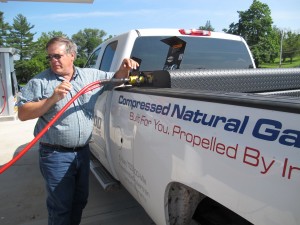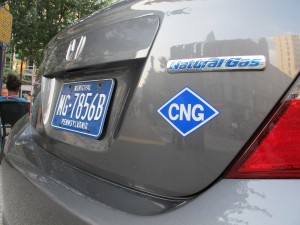Despite abundant supply, natural gas slow to catch on as transportation fuel
-
Marie Cusick

Marie Cusick/ StateImpact Pennsylvania
A customer fills up at a public CNG station in Towanda. There are only about 22 public stations like this one in Pennsylvania.
The most recent Marcellus shale production numbers were record-breaking. If Pennsylvania keeps up this pace, it will be producing enough gas to supply more than 10 percent of what the entire country uses in a year.
And with this glut, there are efforts to find new markets for the gas— especially in transportation.
Compressed natural gas (CNG) can be used as an alternative fuel to power cars and trucks, but it isn’t catching on everywhere.
“Way too much supply”
In Pennsylvania, we have more natural gas than we know what to do with. Alan Walker, who heads the state’s Department of Community and Economic Development, puts it this way:
“It’s an industry that responds to supply and demand. Right now we have way too much supply,” he says. “It’ll balance out, because people aren’t going to drill wells if they can’t make money at it. There was this rush—like the gold rush—and we are producing a lot more than we can absorb.”
Unlike the rush to get the gas out of the ground, there hasn’t been a rush to convert vehicles to natural gas.
The Pennsylvania Department of Transportation just started tracking CNG vehicles and doesn’t have state figures yet, but globally, there are nearly 15 million natural gas vehicles are on the road.
Across the United States, it’s a fraction of that–about 112,000 vehicles, according to the Department of Energy.
James O’Donnell heads Alternative Fuel Solutions, a Clearfield County-based company that specializes in natural gas vehicle conversions.
“[CNG has] caught on everywhere, but here,” he says, “I have customers from outside the country—Trinidad, Vietnam, Thailand—and they come to the United States. I win bets with them all the time because when I pick them up, I tell them, ‘Let’s go talk to 10 people. I guarantee 10 out of 10 don’t know what compressed natural gas is.’ It blows their mind.”
“Heavy-duty is gaining traction”
It might seem surprising because right now CNG is much cheaper and cleaner-burning compared to conventional fuels like gasoline and diesel.
But even in a place like Pennsylvania with an abundant supply of gas, the technology hasn’t caught on among everyday drivers. The vehicles can be prohibitively expensive, costing thousands of dollars more than conventional cars, and the fueling infrastructure just isn’t here.
In fact, less than two dozen public CNG stations are up and running across the entire state.
However, CNG is gaining momentum with businesses that operate large fleets of heavy-duty vehicles—like trucking companies, public transit authorities, and waste haulers.
Michael Gallagher is a senior advisor with the Canadian company, Westport —a major supplier of natural gas vehicle engines.
“The economics is kind of a moving target,” he says. “My own view is that natural gas for heavy-duty [vehicles] is gaining traction.”
Despite his line of work, Gallagher doesn’t see CNG becoming ubiquitous.
“I don’t see a future where it’s very likely you’ll have complete national built-out networks for gasoline, diesel, electric, natural gas, [and] hydrogen. But I think you’ll have areas where you can be using each and some will go more national than others.”
“Build it, and they will come”

Marie Cusick/ StateImpact Pennsylvania
One of Bradford County’s two new Honda Civics that runs on compressed natural gas.
One area that is using CNG is Bradford County.
They produce more gas than anywhere else in the state, and recently purchased a CNG bus and two Honda Civics for their social services department.
Commissioner Mark Smith (D- Bradford) says they used some of the revenue they received under Act 13—the state’s drilling impact fee law.
He says it makes sense because they also have two nearby CNG fuel stations.
“I think our job in government is to encourage cleaner fuels and put our environment first and also save money at the same time,” says Smith.
On the other side of the state, the Lancaster County Solid Waste Management Authority (LCSWMA) is in the midst of switching over to 14 new CNG trucks. They expect the $3 million investment will have a payback time of about five years.
LCSWMA received a state grant from the Department of Environmental Protection to help with the cost and plans to build a fueling station at its waste transfer facility. The project should be completed by May 2014.
The station won’t be open to the public but will instead be available to about a dozen waste hauling companies whose trucks come in and out of the transfer facility throughout the day.
Jim Warner is the CEO of LCSWMA and says so far, none of those other companies have decided to switch to CNG.
“We believe here it’s going to be one those, ‘Build it, and they will come,'” says Warner, “Because every time they deliver here they’ll be seeing a fast-fill canopy that will have a digital price that will be probably two dollars and some-odd-cents less than what they just filled up with, the last time they filled their truck.”
Warner says another benefit is the trash trucks will be quieter and won’t wake people up in the morning.
But not everyone is happy about that.
“I’ve heard people complain too because when they hear that trash truck they quickly run down to the curb and put the trash out. Now they might miss it, because they weren’t able to hear their trash truck.”
The state has been working to promote more CNG conversions.
The DEP has given out millions through its Alternative Fuels Incentive Grant Program, and through Act 13, $20 million was set aside specifically to support conversions to natural gas vehicles.
















